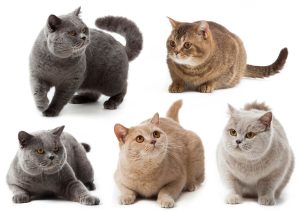Basic information about British Shorthair Cats
British Shorthair cats are a popular and beloved breed known for their distinctive appearance, sweet temperament, and robust health. Here’s an overview of British Shorthairs:
Appearance
British Shorthairs are medium to large-sized cats with a sturdy build and round, chubby faces.
- Body: British Shorthairs have a medium to large-sized, muscular body with a broad chest and sturdy build. They are often described as being “cobby,” meaning they are compact and well-proportioned.
- Head: Their most distinctive feature is their round head, which is set on a short, thick neck. British Shorthairs have a broad skull and prominent cheeks, giving them a distinctly “puffy” appearance.
- Face: They have a short, broad nose with a gentle dip at the eyes, creating a slight “stop” in profile. Their cheeks are full and rounded, contributing to their overall chubby-faced look.
- Eyes: British Shorthairs have large, round eyes that are set wide apart. Their eye color can vary depending on coat color but is typically gold, copper, or orange.
- Ears: Their ears are medium-sized, rounded at the tips, and set wide apart on the head. They sit upright and contribute to the overall rounded appearance of the British Shorthair’s head.
- Coat: The British Shorthair’s coat is short, dense, and plush, with a luxurious feel. It lies close to the body and has a thick undercoat that provides insulation. The coat comes in a wide range of colors and patterns, including solid colors, tabby, bi-color, and calico.
- Tail: Their tail is medium in length, thick at the base, and tapers to a rounded tip. It is proportionate to the body and typically carried straight or with a slight curve.
Temperament
British Shorthairs are known for their calm, affectionate, and easygoing personalities. They are generally laid-back and independent cats that enjoy spending time with their human family members but are also content to entertain themselves when left alone. They are typically good with children and other pets, making them excellent family companions.
History
The British Shorthair breed has a long and storied history that dates back centuries. The British Shorthair’s ancestors are believed to have originated in ancient Rome. They were brought to Britain by the Romans, where they interbred with native European wildcats. These early cats were valued for their hunting abilities and were prized for their skills in controlling rodent populations. Over time, British Shorthairs became popular in England, where they were valued for their excellent temperament and adaptability.
The British Shorthair breed was officially recognized by cat associations in the late 19th and early 20th centuries. Breed standards were established to describe the desired traits of the breed, including their sturdy build, round face, dense coat, and affectionate temperament.

Recognition
The British Shorthair breed was officially recognized by cat registries in the late 19th century. Today, they are recognized by major cat associations such as The International Cat Association (TICA) and the Cat Fanciers’ Association (CFA) and are commonly found in households around the world.
Care
British Shorthairs are generally healthy cats with few breed-specific health issues. They require regular grooming to keep their coats in good condition, but their short fur is relatively easy to maintain. Providing a balanced diet, regular veterinary check-ups, and plenty of mental and physical stimulation are essential for keeping British Shorthairs healthy and happy.
Popularity
British Shorthair cats have remained popular over the years due to their charming appearance, gentle temperament, and easy care requirements. They are often featured in advertisements, movies, and television shows, further contributing to their popularity.
Lifespan
The lifespan of a British Shorthair cat typically ranges from 12 to 20 years, with many individuals living well into their teens or even early twenties with proper care and attention to health. Factors such as genetics, diet, environment, veterinary care, and lifestyle can all influence a British Shorthair’s lifespan.
Providing a balanced diet, regular exercise, routine veterinary check-ups, and a stimulating environment can contribute to a British Shorthair’s overall health and well-being, potentially extending their lifespan. Additionally, responsible breeding practices that prioritize the health and longevity of the breed can help reduce the risk of genetic health issues that may affect lifespan.
As with any cat breed, it’s essential to monitor a British Shorthair’s health closely and address any health concerns promptly to ensure they live happy, healthy, and comfortable lives. With proper care, British Shorthairs can make wonderful companions for many years, bringing joy and companionship to their owners.

Overall, British Shorthair cats are cherished companions known for their sweet nature, striking appearance, and adaptability to various lifestyles. They make excellent pets for families, singles, and seniors alike, providing love, companionship, and entertainment to their owners.
More posts you might be interested in:

